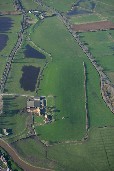Athelney Abbey
Athelney is a long narrow island of hard geology in the Parrett valley surrounded by deposits of silt, clay and peat. In the middle Bronze Age a forest of oak and alder trees existed to the north of the island. Late Bronze Age oak piles have been found that may once have formed a bridge across to the Lyng peninsula only 300m to the south- west. In the Iron Age bank and ditch defences were made on the end of the hill facing Lyng suggesting a use as the lowest hillfort in the UK.Athelney means ‘Island of the Princes’ in Anglo-Saxon, possibly a reference to post-Roman occupation of the site when the defences appear to have been reused before the area’s conquest by the Saxon kingdom of Wessex. In 878 AD a great Viking army overran the kingdom of Wessex forcing King Alfred to seek refuge in the swamp-fastness of Athelney where he reused the Iron Age fortifications. The island was surrounded by impenetrable wet alder woods and could only be reached by small boats or by a bridge to Lyng. Excavations at Athelney have found evidence of metalworking from this period.
Alfred eventually left Athelney to defeat the Vikings and force their leader to be baptised at nearby Aller. He subsequently founded a monastery at Athelney, the plan of which has been revealed by a recent geophysical survey. Lyng became a fortified settlement or ‘burgh’, the bank and ditch defences of which can still be seen cutting off the end of the peninsula by East Lyng church. A Medieval flood bank, the Baltmoor Wall, was constructed between Lyng and Athelney in the 12th century AD and the River Tone diverted to its present course.

